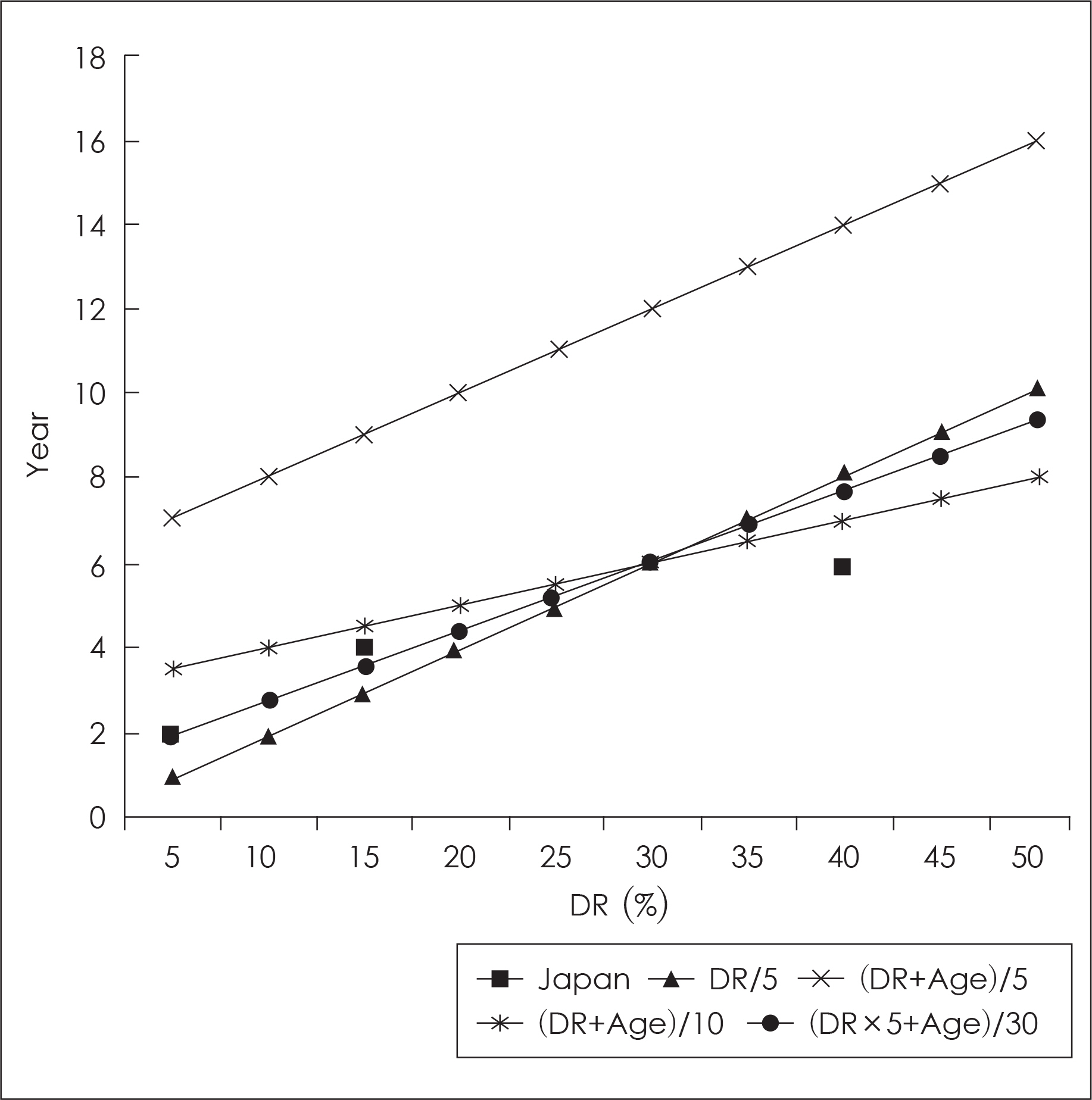Korean J Neurotrauma.
2012 Apr;8(1):10-14. 10.13004/kjnt.2012.8.1.10.
An Ideal Method of Calculating the Approved Period of Disability
- Affiliations
-
- 1Department of Neurosurgery, Cheonan Hospital, Soonchunhyang University College of Medicine, Cheonan, Korea. ksleens@sch.ac.kr
- KMID: 1427676
- DOI: http://doi.org/10.13004/kjnt.2012.8.1.10
Abstract
OBJECTIVE
In 1980s, so-called approved period of disability was imported to Korea from Japan to control the excess of compensation which was caused by an inappropriate rule for disability evaluation. However, there were neither objective criteria nor established area for the approved period of disability. Now, the objectivity and credibility of the disability evaluation become a serious problem. We tried to solve this problem.
METHODS
We examined the time of import and background of the approved period of disability. We also investigated the status and problems of deciding the approved period of disability. We used an internet search using the keywords the approved period of disability in the Korean Supreme Court (http://glaw.scourt.go.kr/jbsonw/jbson.do).
RESULTS
We found 11 precedents with full text. The approved period of disability was applied only for the disability from spinal injuries at first. The application area became wider. It was used as an expedient to negotiate the indemnities. In 2010, the Korean Academy of Medical Sciences made a new guideline as an appropriate rule for disability evaluation. A new method is necessary for calculating the average or acceptable period of disability instead of the approved period of disability.
CONCLUSION
We proposed an ideal method of compensation according to the age and the degree of disability, i.e., (Disability Rate+Age)/5. This formula can be applied when the age was between 21-49 years old and the disability rate was less than 50%.
MeSH Terms
Figure
Reference
-
1). Ahn KH. Several problems of the expert opinion on the disability evaluation in the court. Booklet of the 9th Congress of the Korean Compensation Medicine, pp33-48. 1995.2). Hwang SC., Lee KS. A Korean Academy of Medical Sciences guides for the evaluation of permanent impairment. J Korean Med Assoc. 52:573–578. 2009.
Article3). Kim CH. Problems and remedy of the Korean system for disability evaluation. A source book of public hearing for unification of the Korean system for disability evaluation. 2005.4). Kim BH., Yi SR. Issues of Disability Evaluation: Difficulties, Inappropriateness and Proposals. J Korean Med Assoc. 52:558–566. 2009.
Article5). Lim KS. A New Method for Physical Impairment Rating. Seoul: Jinsu Publishing Company, pp28-55. 1995.6). Lee KS. Disability evaluation. J Korean Med Assoc. 51:664–671. 2008.
Article7). Lee KS. Medical Consideration on the Reparation and Compensation, ed 4. Seoul: Jungang Munhwasa, pp166-171. 2006.8). Lim KS. My opinion on the intervertebral disc herniation and sprain. J Korean Compensation Med. 4:1–7. 1992.9). Lim KS. Windfall of 30,000,000 won. J Korean Compensation Med. 1:3–6. 1992.10). Lee KS., Won JU., Kim SY., Sohn MS., Youm YS., Lee YS, et al. Development of the Korean Academy of Medical Sciences Guideline for Rating Physical Impairment. J Korean Med Sci 24: S221-S226. 2009.
Article11). McBride ED. Disability evaluation and principles of treatment of compensable injuries, ed 6. Philadelphia: JB Lippincott Co, pp68-103. 1963.12). Rondinelli RD. Guides to the Evaluation of Permanent Impairment, ed 6. San Diego: American Medical Association. 2008.
- Full Text Links
- Actions
-
Cited
- CITED
-
- Close
- Share
- Similar articles
-
- Medicolegal Considerations in Hearing Injury with an Aggravation of Disability
- Comparative consistency between obesity determination standards using Body Mass Index and Ideal body weight
- The Simple Calculating Method of Fracture Area in Orbital Fracture
- A Review of the Types and Characteristics of Healthy Life Expectancy and Methodological Issues
- McBride’s Disability Assessment: Why Is It Still Most Used?


